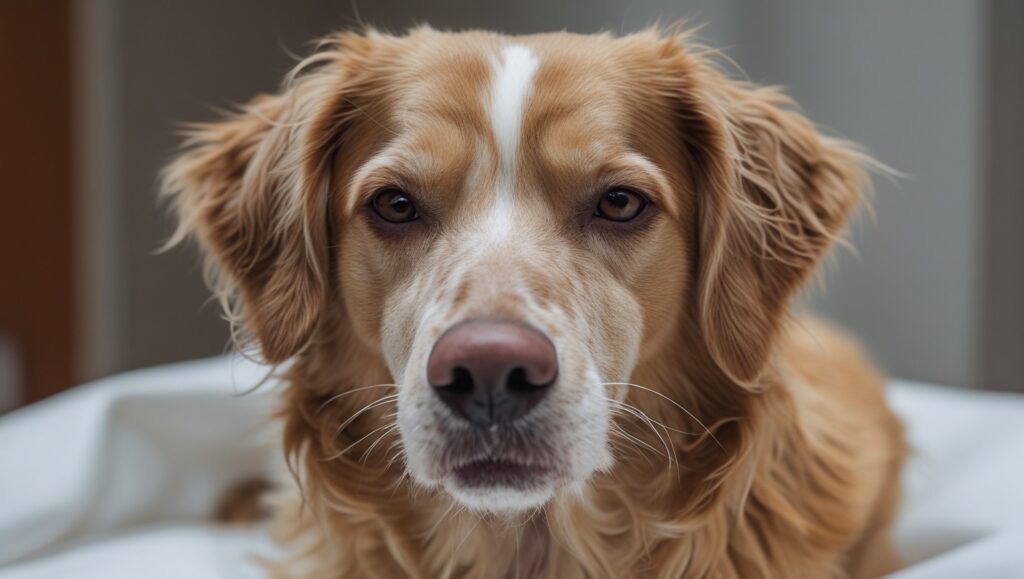Most pet owners would not know that dog skin diseases are not uncommon. Whether it is itchiness or severe infections, skin allergies in your furry baby may go unnoticed until it is too late, if you do not notice the early signs of this problem. These are the most frequent types of dog skin diseases with pictures discussed in this article with photographs, signs and symptoms, causes and what to do. Learning these circumstances would help you safeguard the skin of your dog and have a happy and healthy existence.
Table of Contents

1. Flea Allergy Dermatitis
Close-up of red inflamed skin of a dog, which is caused by fleas
Flea allergy dermatitis is one of the most typical dog skin conditions, which is a hypersensitive reaction to the flea bite. The bite itself is not the problem, but the saliva in the flea that causes extreme itching.
Symptoms:
- Severe scratching and biting.
- bright, inflamed spots, particularly at the base of the tail.
- Baldness or bald fur.
Cause: flea infestation
Treatments: Flea preventative products applicated to the dog, creams to prevent itching, baths that are medicated
2. Demodectic Mange (Sarcoptic Mange)
Bald spots on the face or legs of a dog or crusty skin areas
Mange is a parasitic disease of the skin which is caused by microscopic mites. It is fast to spread and should be addressed with urgency.
Symptoms:
- Severe itching
- Dry rough skin
- Baldness in the form of circles.
Cause: Mite-infestation of mites
Therapies: Oral or topical prescriptions are made, medicated shampoos
3. Hot Spots (Acute Moist Dermatitis in Dogs)
Red, moist, painful-looking patch on the neck or hip
A hot spot is an inflamed area of the skin, which happens rapidly if a dog licks, chews or scratches it.
Symptoms:
- Wet,snotty sore,
- Pain-ridden and swollen.
- Typically consumes hair fall.
Cause: Acne allergy, a sting of insects or infections under the eye
Treatment: Wound debridement, antibiotics, anti inflammatory medication
4. Yeast Infections
Red, oily skin in the dog’s ears or between the toes
Yeasts can overgrow in warm, humid places and then infect the ears or the paws.

Symptoms:
- Itchy skin
- Musty odor
- Greasy/dirty discoloured patches
Cause: Immune systems are compromised or allergic.
Therapy: Cream antifungal, antifungal wipes /antifungal sprays.
5. Ringworm (Dermatophytosis)
Round, shaved area of the body or face
The ringworm name notwithstanding, it is a fungal infection. It may be transmitted to both people and animals.
Symptoms:
- Red circular spots
- Scalp and hair loss
- Mild itching
Cause: Spores from fungal-contaminated surface or animal
Therapy: Cleaning environment, antifungal creams, antifungal drugs
6. Pyoderma Bacterial Skin Infection
Description of the image: Bacterial pustules or rash of red colour on the abdomen or crevices
Bacteria get the chance to produce secondary infections in your dog when the skin barrier is broken.

Symptoms:
- Pustules or pimples
- Sor and inflammation
- Painful and itchy skin
Reasons: Allergy, scar or moisture build up
Therapy: antibiotics, antibacterial shampoos, control of the cause
7. Seborrhea
Seborrhea leads to dry skin or oily skin. It may be hereditary or the symptom of some other disorder.
Symptoms:
- Oily hair or dry dandruff
- Foul odor
- Itching
Causative: Allergic, Hormone imbalance, or genetic
Treatment: Supplements, medicated shampoos, treatment on root condition
8. Contact Dermatitis
Red, angry skin on the belly or paws after taking a walk outside
It is the allergic response to the things that your dog is in contact with, i.e. grass, soap or carpet.

Symptoms:
- Red irritating skin
- Bumps or blisters
- Overlicking of the paws
Cause: Chemicals, plants or fabrics which are irritants
Therapy: antigen accent, chilled creams, anti-histamine
9. Food Allergies
Swelling or rashes near the mouth or ears
Food allergies may cause digestive problems and skin problems.
Symptoms:
- Chronic infections in the ears
- Rash or itchiness of the skin
- Vomiting or diarrhoea
Cause: Allergy to e.g. such proteins as beef, chicken, grains etc.
Medication: Elimination diet, hypoallergenic food
10. Autoimmune Skin Disease (Lupus)
Ulcers or scabs in the nose, ears and paws
Lupus is a severe autoimmune disorder in which the body’s immune system damages its dermal cells.
Symptoms:
- Nose, eyes-crusting
- Unhealing wounds
- Turning pale or loss of colour of the nose.
Cause: Autoimmune condition
Therapy: Using immunosuppressive medications, frequent vet observation
At What Time to See Your Vet?
Do not hesitate in case your dog is seen to have chronic itching, excess shedding or changes in the skin. There are skin diseases that may develop into severe and transmissible conditions. It is important to be diagnosed and treated early.

Prevention Tips
- Make your dog groomed and clean.
- Apply flea/tick control products which are approved by vets.
- Eat a well-balanced, quality food diet.
- The best way is to prevent your dog, of course, from known allergens.
Conclusion
Having an idea of the types of dog skin diseases with pictures allows the pet owners to be aware of the earliest indications of the urge and frustrations of their pets. It may be fleas, allergies, mange or it may be just a bacterial infection, and in any of these cases, timing is everything since in case of early diagnosis and treatment, there is nothing to worry about progression. Be observant and be keen to the behavior of your dog, check his or her skin when you groom him or her and consult a veterinarian immediately if you notice something suspicious. It is just that your dog will equally be well off with the wagging tail, only that with proper care, balanced diet and prophylaxis.
FAQs
Can humans get dog skin diseases?
Yes, ringworm or mange is contagious to human beings. Hand washing and surface disinfection should be done everywhere.
What are home made remedies to itchy dog skin?
A relief can be shared by oatmeal baths, coconut oil, and aloe vera, but consult the veterinarian.
What is the frequency of bathing my dog to ward off skin problems?
Every 4-6 weeks, typically, but perhaps more often based on a recommendation of medicated baths by your vet.




Pingback: Yeast Dog Ear Infection Picture: 5 Symptoms and How to Treat It
Pingback: Top 10+ Pictures of Pyoderma in Dogs: Types, Causes & Treatment